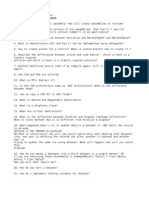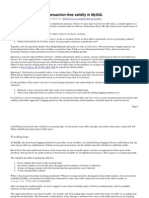0 ratings0% found this document useful (0 votes)
91 viewsES6 LinkedIn Learning
ES6 LinkedIn Learning
Uploaded by
Solution GuruThis document provides an overview of key concepts in ECMAScript 6 (ES6) and beyond. It discusses topics like transpiling code to support older browsers, using Babel and Webpack, variable declarations with let and const, template strings, spread operators, default function parameters, arrow functions, destructuring assignment, generators, promises, async/await, classes and more. The questions aim to test understanding of new JavaScript features introduced after ES5.
Copyright:
© All Rights Reserved
Available Formats
Download as PDF, TXT or read online from Scribd
ES6 LinkedIn Learning
ES6 LinkedIn Learning
Uploaded by
Solution Guru0 ratings0% found this document useful (0 votes)
91 views2 pagesThis document provides an overview of key concepts in ECMAScript 6 (ES6) and beyond. It discusses topics like transpiling code to support older browsers, using Babel and Webpack, variable declarations with let and const, template strings, spread operators, default function parameters, arrow functions, destructuring assignment, generators, promises, async/await, classes and more. The questions aim to test understanding of new JavaScript features introduced after ES5.
Original Description:
ES6 LinkedIn Learning
Copyright
© © All Rights Reserved
Available Formats
PDF, TXT or read online from Scribd
Share this document
Did you find this document useful?
Is this content inappropriate?
This document provides an overview of key concepts in ECMAScript 6 (ES6) and beyond. It discusses topics like transpiling code to support older browsers, using Babel and Webpack, variable declarations with let and const, template strings, spread operators, default function parameters, arrow functions, destructuring assignment, generators, promises, async/await, classes and more. The questions aim to test understanding of new JavaScript features introduced after ES5.
Copyright:
© All Rights Reserved
Available Formats
Download as PDF, TXT or read online from Scribd
Download as pdf or txt
0 ratings0% found this document useful (0 votes)
91 views2 pagesES6 LinkedIn Learning
ES6 LinkedIn Learning
Uploaded by
Solution GuruThis document provides an overview of key concepts in ECMAScript 6 (ES6) and beyond. It discusses topics like transpiling code to support older browsers, using Babel and Webpack, variable declarations with let and const, template strings, spread operators, default function parameters, arrow functions, destructuring assignment, generators, promises, async/await, classes and more. The questions aim to test understanding of new JavaScript features introduced after ES5.
Copyright:
© All Rights Reserved
Available Formats
Download as PDF, TXT or read online from Scribd
Download as pdf or txt
You are on page 1of 2
LinkedIn Learning
ECMAScript 6+ (ES6+)
1. What does ECMA stand for?
European Computer Manufacture Association
2. When will ES6 features work in the browser?
when the browser supports all of the features
3. What is transpiling?
the process of converting code to a format that can be read by a
browser
4. When you use Babel, what is the output?
code that works in a browser
5. What attribute must you add to a script tag when using the in-
browser transpiler?
type="text/babel"
6. What does webpack help developers to do?
Automate processes like transpiling and sass to css conversion.
7. What is the most important change in the webpack config file
from webpack 1 to webpack 3?
he object key called "loaders" becomes "rules"
8. Why might you use the 'let' keyword instead of 'var'?
to enforce block scoping
9. What happens if you try to reset a variable that has been
declared as a constant?
console error
10. Are spaces recognized within a template string?
Yes, any spaces or characters are recognized.
11. What punctuation makes up the spread operator?
...
12. If a value is provided to a function that has default
arguments, what happens to the default arguments?
they are overwritten
13. What is the purpose of object literal enhancement?
shorter syntax, less typing
14. What does an arrow function point to?
whatever the function returns
15. Besides aesthetics, why might you want to use arrow
functions in your code?
to keep 'this' in scope
16. Where can you use destructuring assignment?
all of these answers
17. How do we hit pause in a generator?
use the yield keyword
18. Why are Symbols primarily used?
to create unique ids
19. What is the iterable protocol?
a way to customize iteration behavior
20. What is the purpose of promises?
to help developers manage asynchronous behavior in JavaScript
21. How do you return a promise object?
use return new promise()
22. What do you pass in to the fetch function?
a url that you want to fetch from
23. How can you use async/await in Node.js?
Use node version 8.
24. How do you make fetch asynchronous?
You can't since Fetch is already asynchronous.
25. What happens when you use the 'new' keyword with ES6
classes?
a new instance of the class is created
26. When a new instance of a class is created, what happens to
the custom methods in the base class?
They are inherited by the subclass.
27. What is a getter?
a method that gets the value of a property
You might also like
- 55106-Typescript Javascript's Superset SolutionDocument4 pages55106-Typescript Javascript's Superset SolutionSolution Guru50% (12)
- 55106-Typescript Javascript's Superset SolutionDocument4 pages55106-Typescript Javascript's Superset SolutionSolution Guru50% (12)
- Swift For Complete Beginners 2022-05-29 (Just The PDFDocument232 pagesSwift For Complete Beginners 2022-05-29 (Just The PDFMaratana Vem senhorNo ratings yet
- Qatar OM PART C PDFDocument796 pagesQatar OM PART C PDFBobi Guau100% (5)
- Adobe AEM QuestionsDocument3 pagesAdobe AEM QuestionsRahul SainiNo ratings yet
- Question .Net CoreDocument8 pagesQuestion .Net CorevdshfsdfhsdvNo ratings yet
- FullstacksyllabusDocument4 pagesFullstacksyllabusDhanushNo ratings yet
- Node - Js Interview Questions: Click HereDocument21 pagesNode - Js Interview Questions: Click Hereazamat aliqulovNo ratings yet
- Frontend Interview QuestionsDocument13 pagesFrontend Interview QuestionsYoussef IbrahemNo ratings yet
- Dot Net BasicDocument9 pagesDot Net BasicPirai VadivuNo ratings yet
- Quick Reference Before Appearing For Java InterviewDocument8 pagesQuick Reference Before Appearing For Java InterviewAnubhav SahooNo ratings yet
- CCCCCCCC C C CCCCCCCCCCCCCCCCCCCCCCCCC CDocument9 pagesCCCCCCCC C C CCCCCCCCCCCCCCCCCCCCCCCCC CSanjay KumarNo ratings yet
- Interviw QuestionsDocument39 pagesInterviw QuestionsApache RTRNo ratings yet
- Building iOS 17 Apps with Xcode Storyboards: Develop iOS 17 Apps with Xcode 15 and SwiftFrom EverandBuilding iOS 17 Apps with Xcode Storyboards: Develop iOS 17 Apps with Xcode 15 and SwiftNo ratings yet
- FullStackDev Important QuestionsDocument2 pagesFullStackDev Important QuestionsmibaNo ratings yet
- What You Need To Know About Node - Js (Ebook)Document49 pagesWhat You Need To Know About Node - Js (Ebook)Sekti Wicaksono67% (3)
- Node JS Hand Book 1654187904Document49 pagesNode JS Hand Book 1654187904Rąmżi ĄbidNo ratings yet
- NET Interview QuestionsDocument8 pagesNET Interview QuestionsAmandeep 'Johny' SinghNo ratings yet
- C# Interview QuestionsDocument5 pagesC# Interview Questionskukugudu0% (1)
- 10 Tips and Tricks That Will Make You A Better ReactJS DevDocument32 pages10 Tips and Tricks That Will Make You A Better ReactJS DevJhonathan AntonioNo ratings yet
- Faq JS 2Document20 pagesFaq JS 2maajinbuu132No ratings yet
- Interview QuestionsDocument17 pagesInterview Questionsvallerusunil128_5521No ratings yet
- Scenario Based QuestionsDocument5 pagesScenario Based QuestionsRahul MukherjeeNo ratings yet
- DevOps 5Document31 pagesDevOps 5ghazi ben abdallahNo ratings yet
- Java Full Stack Interview QuestionsDocument5 pagesJava Full Stack Interview QuestionscsamalaridsonjNo ratings yet
- Learn ASP.NET Core MVC - Be Ready Next Week Using Visual Studio 2017From EverandLearn ASP.NET Core MVC - Be Ready Next Week Using Visual Studio 2017Rating: 5 out of 5 stars5/5 (1)
- All Interview Question-1Document23 pagesAll Interview Question-1SHAILESH JORENo ratings yet
- JS Interview QuestionDocument9 pagesJS Interview Questionmujahidul islamNo ratings yet
- Ebin - Pub Become A Ninja With Vue 2023-05-19nbspedDocument406 pagesEbin - Pub Become A Ninja With Vue 2023-05-19nbspedAhmed RaedNo ratings yet
- Interview QuestionsDocument3 pagesInterview QuestionsSuman MondalNo ratings yet
- DotNet SQL Interview QuestionsDocument167 pagesDotNet SQL Interview QuestionsDuccati ZiNo ratings yet
- Features in Vs2008Document12 pagesFeatures in Vs2008umeshshivakanthNo ratings yet
- ASPDocument11 pagesASPńazli AhmedNo ratings yet
- 4 - .Net CoreDocument18 pages4 - .Net Coreaitc.dbaNo ratings yet
- How To Build Micro Frontends Using Module Federation in AngularDocument19 pagesHow To Build Micro Frontends Using Module Federation in Angularjagruti patilNo ratings yet
- Exp:0-10 Yrs Difficulty Level: Easy To Moderate: Common and Random QuestionsDocument3 pagesExp:0-10 Yrs Difficulty Level: Easy To Moderate: Common and Random QuestionsRiya RoyNo ratings yet
- Real Time Interview QuestionsDocument8 pagesReal Time Interview QuestionsDibyamadhuri OjhaNo ratings yet
- All Qa-1Document136 pagesAll Qa-1SHAILESH JORENo ratings yet
- DotNet SQL Interview QuestionsDocument115 pagesDotNet SQL Interview Questionsapi-3736566100% (1)
- Devops & AWSDocument13 pagesDevops & AWSSriNo ratings yet
- 4 Companies Technical RoundDocument6 pages4 Companies Technical RoundAjay Chowdary Ajay ChowdaryNo ratings yet
- Alberto Montalesi Complete Guide To Modern JavaScript - 2020Document204 pagesAlberto Montalesi Complete Guide To Modern JavaScript - 2020ruben100% (1)
- UIQuestionsDocument2 pagesUIQuestionssuryachandra4youNo ratings yet
- Part 3Document7 pagesPart 3RakshasiNo ratings yet
- Interview Questions and AnswerDocument29 pagesInterview Questions and AnswerJayyant ChaudhariNo ratings yet
- Node - Js Interview Questions: PremiseDocument19 pagesNode - Js Interview Questions: PremiseSaurabh SinghNo ratings yet
- PHP Developer Interview QuestionsDocument9 pagesPHP Developer Interview Questionsparthi288250No ratings yet
- PHP Interview Questions For Freshers 2018Document16 pagesPHP Interview Questions For Freshers 2018rajan digitalNo ratings yet
- Full Stack Web Development Course - BrochureDocument35 pagesFull Stack Web Development Course - Brochuregamingbrothers201510100% (1)
- JSP Interview Questions and AnswersDocument7 pagesJSP Interview Questions and AnswerssonamNo ratings yet
- Spring 5.0 Question and AnswersDocument24 pagesSpring 5.0 Question and AnswersAl-Etihad InvoiceNo ratings yet
- OceanofPDF - Com The React Mega-Tutorial Learn Front End Development With React by Building A Complete Project Step-By-Step - Miguel GrinbergDocument305 pagesOceanofPDF - Com The React Mega-Tutorial Learn Front End Development With React by Building A Complete Project Step-By-Step - Miguel Grinbergwitolo8352No ratings yet
- Full Stack Roadmap: OpinionsDocument8 pagesFull Stack Roadmap: OpinionsSarim AhmedNo ratings yet
- Hybris Interview QuestionsDocument7 pagesHybris Interview Questionsanon_516928873100% (1)
- Appliness #13 - April 2013Document128 pagesAppliness #13 - April 2013Serghei CebotariNo ratings yet
- Practical Java 8: Lambdas, Streams and new resourcesFrom EverandPractical Java 8: Lambdas, Streams and new resourcesRating: 5 out of 5 stars5/5 (1)
- Learn Kubernetes & Docker - .NET Core, Java, Node.JS, PHP or PythonFrom EverandLearn Kubernetes & Docker - .NET Core, Java, Node.JS, PHP or PythonNo ratings yet
- Int QuestionsDocument5 pagesInt Questionsramaganeshram100% (1)
- Drupal Interview QuestionsDocument6 pagesDrupal Interview QuestionsAnand PhadnisNo ratings yet
- JavaScript Patterns JumpStart Guide (Clean up your JavaScript Code)From EverandJavaScript Patterns JumpStart Guide (Clean up your JavaScript Code)Rating: 4.5 out of 5 stars4.5/5 (3)
- C CC CCCCC CCC C C CCCCCCCCC C CC C!CCCCC C "CCC CCCCDocument4 pagesC CC CCCCC CCC C C CCCCCCCCC C CC C!CCCCC C "CCC CCCCbokobokikoNo ratings yet
- SAST CheckmarxDocument6 pagesSAST CheckmarxSolution Guru100% (1)
- SAST Checkmark Fresco PlayDocument1 pageSAST Checkmark Fresco PlaySolution GuruNo ratings yet
- JavaScript LinkedIn LearningDocument13 pagesJavaScript LinkedIn LearningSolution GuruNo ratings yet
- Programming Foundations Version Control With GitDocument4 pagesProgramming Foundations Version Control With GitSolution GuruNo ratings yet
- Junit5 LinkedIn LearningDocument3 pagesJunit5 LinkedIn LearningSolution GuruNo ratings yet
- Modulation Formats in Optical Communication SystemDocument7 pagesModulation Formats in Optical Communication SystemAijaz AhmedNo ratings yet
- A 150.xx Service Black/ITU Cartridge Motor Error On A Lexmark C54x and X54x Series PrinterDocument4 pagesA 150.xx Service Black/ITU Cartridge Motor Error On A Lexmark C54x and X54x Series Printerahmed salemNo ratings yet
- Shortcuts For The QTS Numeracy Test PDFDocument5 pagesShortcuts For The QTS Numeracy Test PDFqtstutorNo ratings yet
- Taylor and Maclaurin SeriesDocument38 pagesTaylor and Maclaurin SeriescholisinaNo ratings yet
- Slider-Connecting Rod MechanismDocument2 pagesSlider-Connecting Rod MechanismYu LoengNo ratings yet
- SDCDocument14 pagesSDCmanojkumarNo ratings yet
- Leqsikon Excel 10-1Document478 pagesLeqsikon Excel 10-1Vano GvencadzeNo ratings yet
- enDocument60 pagesenRegistr Registr100% (2)
- Fundamentals of Telecommunications: Ermanno Pietrosemoli Marco ZennaroDocument34 pagesFundamentals of Telecommunications: Ermanno Pietrosemoli Marco Zennarosunil vermaNo ratings yet
- Cooking Facility BOQDocument11 pagesCooking Facility BOQgobinathrengarajanNo ratings yet
- Molecular Composition of CellsDocument92 pagesMolecular Composition of CellsJb PalmaNo ratings yet
- Chemistry Project For Class 12Document19 pagesChemistry Project For Class 12khax100% (1)
- CAL Research Methodology Unit IDocument79 pagesCAL Research Methodology Unit ISake ShinNo ratings yet
- Transaction Time Validity in MySQLDocument12 pagesTransaction Time Validity in MySQLManish GourNo ratings yet
- The Compact Disc Formats Technology and Applications - KenPolhmann - 1988Document30 pagesThe Compact Disc Formats Technology and Applications - KenPolhmann - 1988camt2112No ratings yet
- ITSM Scenarios Use Cases 1706233225Document12 pagesITSM Scenarios Use Cases 1706233225dsg1607No ratings yet
- 1Z0 533 PDFDocument7 pages1Z0 533 PDFGyan PrakashNo ratings yet
- Thermodyanamics PqyDocument257 pagesThermodyanamics PqySiddhrajsinh ZalaNo ratings yet
- 1.3.7 Latent HeatDocument12 pages1.3.7 Latent HeattuNo ratings yet
- GR hw3 Berke TozluDocument5 pagesGR hw3 Berke TozluAyberk BulutNo ratings yet
- R Regress Post Estimation Time SeriesDocument12 pagesR Regress Post Estimation Time SeriesNguyen Nhu Ngoc DieuNo ratings yet
- Alam Et Al. - 2021 - Factors Influencing MHealth Adoption and Its Impact On Mental Well-Being During COVID-19 Pandemic A SEM-ANN ApproacDocument36 pagesAlam Et Al. - 2021 - Factors Influencing MHealth Adoption and Its Impact On Mental Well-Being During COVID-19 Pandemic A SEM-ANN Approacdani malikNo ratings yet
- Lithium Ion Battery For Telecom ApplicationsDocument9 pagesLithium Ion Battery For Telecom ApplicationsPravesh Kumar ThakurNo ratings yet
- Meetup OpenStack Cologne Fundamentals WorkshopDocument49 pagesMeetup OpenStack Cologne Fundamentals WorkshopKanchan ChakrabortyNo ratings yet
- Wa0012.Document50 pagesWa0012.mohammad97kaifNo ratings yet
- UART ArchitectureDocument23 pagesUART ArchitectureEdgar Mugabi Tusuubira100% (4)
- DMiner Dashboard Design Mining and RecommendationDocument14 pagesDMiner Dashboard Design Mining and RecommendationhobelNo ratings yet
- M Tech Seminar TopicDocument11 pagesM Tech Seminar TopicDenny Eapen ThomasNo ratings yet
- Driller's Console Chapter 4 PDFDocument41 pagesDriller's Console Chapter 4 PDFpabloNo ratings yet































































































